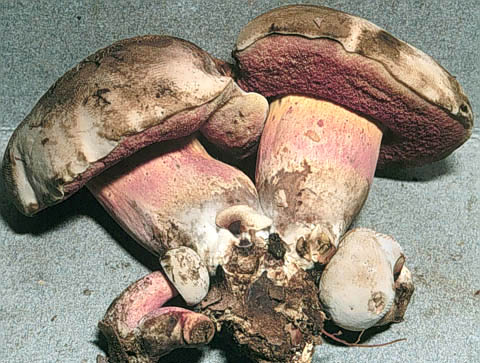
Photograph by R. E. Halling, © 1997
This taxon bears resemblance to C. calopus (Fr.) Vizzini, C. inedulis (Murrill) Vizzini, and C. rubripes (Thiers)Vizzini because of the pallid pileus coloration, bitter taste and pink to red tones on the stipe. However, those boletes do not have red pores. Caloboletus rubripes has a glabrous stipe but lacks the amyloid hyphal walls in the pileipellis and trama. Caloboletus calopus possesses amyloid hyphae but has a conspicuously reticulate stipe as does C. inedulis. Also, C. calopus and C. rubripes seem to associate with conifers, although Thiers (1975) mentioned that oaks are often in the vicinity where C. rubripes occurs in north coastal California. Caloboletus inedulis is found in oak-hickory woods in Michigan according to Smith and Thiers (1971) and oak or mixed woods of beech, oak and hemlock (Both 1993). In addition, there is resemblance to B. manicus Heim from New Guinea (Both 1993) and B. quercinus Hongo non Schrad. from Japan (Both pers com). The former is very similar in both macro- and microscopic characters, but has a more heavily reticulated stipe, while the latter differs mainly in its mild taste. Caloboletus firmus was known previously from oak woods in eastern North America, south to North Carolina (Both 1993), Georgia and Mississippi (Weber and Smith 1985). Frost's (1874) original description was terse but covered the salient features. According to Both (1993), B. piedmontensis Grand & A. H. Sm. is clearly a later synonym (illustrated in Weber & Smith 1985). In addition to the similarities in overall colors and microscopic structures mentioned by Both (1993), B. piedmontensis also has amyloid areas on the hyphal walls of the pileipellis (Grand & Smith 1971, Treu 1993). The most complete description of C. firmus is that of Grand & Smith (1971, as B. piedmontensis). The spores of the Costa Rican material are slightly broader than that mentioned by Halling (1983) in his type study [(2.8–)3.4–4.6(–5) µm]. The specimen shown came from under Quercus oleoides at the Agua Thermales area in sector Santa Maria on Rincon de la Vieja of the Guanacaste Conservation Area. The pink color on the stipe will disappear with age.